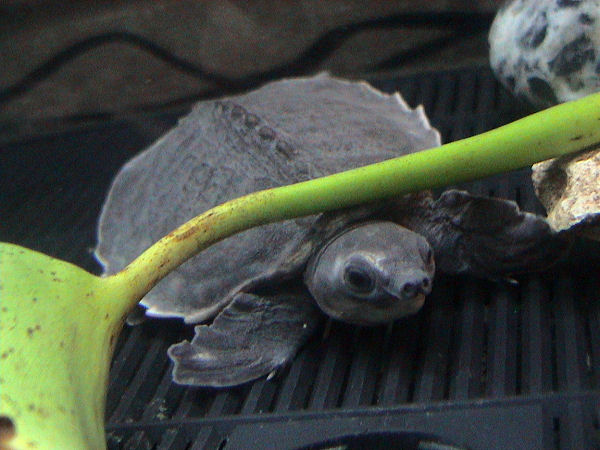|
| Query: Pig | Result: 38th of 786 | |
Pig-nosed Turtle (Carettochelys insculpta) - Wiki
| Subject: | Pig-nosed Turtle (Carettochelys insculpta) - Wiki
| |

| Resolution: 600x450
File Size: 69528 Bytes
Date: 2004:09:19 18:04:55
Camera: DCR-TRV740 (SONY)
F number: f/1.6
Exposure: 1/60 sec
Focal Length: 46/10
Upload Date: 2007:10:16 13:39:02
|
Pig-nosed Turtle
From Wikipedia, the free encyclopedia
[Photo] Pig-nosed Turtle (Carettochelys insculpta). Date 19 September 2004. Photo by http://en.wikipedia.org/wiki/User:Dawson
The Pig-nosed Turtle (Carettochelys insculpta), also known as the Australasian Pig-nose Turtle, Pitted-shelled Turtle, Plateless Turtle or Fly River Turtle, is a species of soft-shelled turtle native to freshwater streams, lagoons and rivers of the Northern Territory of Australia and of southern New Guinea. It is the only species in the genus Carettochelys, and the family Carettochelyidae.
Subspecies
There are two subspecies:
Carettochelys insculpta insculpta (Ramsay, 1887)
Carettochelys insculpta canni (Wells, 2002)
Description
The Pig-nosed Turtle is unlike any other species of freshwater turtle in the world. The carapace is typically grey in colour, with a leathery texture, while the plastron is cream-coloured. The feet are flippers, resembling those of marine turtles. The nose looks like that of a pig, having the nostrils at the end of a fleshy snout, hence the common name. Males can be distinguished from females by their longer tails . Pig-nosed Turtles can grow to about 70 cm shell-length, with a weight of over 20 kg.
Behaviour
Pig-nosed Turtles are almost entirely aquatic. Little is known about general behaviour as there have been few studies in the wild. Their aggressiveness in captivity seems to suggest that this species is markedly more territorial than most other turtles and tortoises.
Diet
The species is omnivorous, eating a wide variety of plant and animal matter, including the fruit and leaves of the fig as well as crustaceans, molluscs and insects.
Breeding
Females do not reach maturity until at least 25 years old. They lay their eggs late in the dry season on sandy river banks.
In captivity
Pig-nosed Turtles have become available through the exotic pet trade, with a few instances of captive breeding. While juveniles are small and grow slowly, their high cost and large potential size makes them suitable only for experienced aquatic turtle keepers. They tend to be shy and prone to stress, which can cause problems with their feeding, but they are known to eat commercially available processed turtle pellets or trout chow, as well as various fruits and vegetables. Breeding is rarely an option to the hobbyist, as adults are highly aggessive and will attack each other in all but the largest enclosures.
http://en.wikipedia.org/wiki/Pig-nosed_Turtle
| The text in this page is based on the copyrighted Wikipedia article shown in above URL. It is used under the GNU Free Documentation License. You may redistribute it, verbatim or modified, providing that you comply with the terms of the GFDL. |
|
^o^
Animal Pictures Archive for smart phones
^o^
|
|

